
Little Round Top is the smaller of two rocky hills south of Gettysburg, Pennsylvania—the companion to the adjacent, taller hill named Big Round Top. It was the site of an unsuccessful assault by Confederate troops against the Union left flank on July 2, 1863, the second day of the Battle of Gettysburg, during the American Civil War.
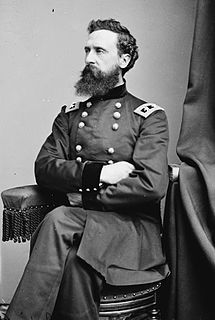
George Sykes was a career United States Army officer and a Union General during the American Civil War.

John Henry Hobart Ward, most commonly referred to as J.H. Hobart Ward, was a career United States Army soldier who fought in the Mexican–American War and served in the New York state militia. He also served as a Union general during the American Civil War.

During the second day of the Battle of Gettysburg Confederate Gen. Robert E. Lee attempted to capitalize on his first day's success. His Army of Northern Virginia launched multiple attacks on the flanks of the Union Army of the Potomac, commanded by Maj. Gen. George G. Meade. The assaults were unsuccessful, and resulted in heavy casualties for both sides.

Thomas Casimer Devin was a United States Army officer and general. He commanded Union cavalry during the American Civil War and during the Indian Wars.
The 14th Indiana Infantry Regiment, later referred to as the Gallant Fourteenth, was an infantry regiment and part of the Union Army's celebrated "Gibraltar Brigade" of the Army of the Potomac during the American Civil War. Organized in May 1861 at Camp Vigo, near Terre Haute, Indiana, it was the state's first regiment organized for three years of service. The 14th Indiana served in major campaigns and battles in the Eastern Theater, mostly in West Virginia, Virginia, Pennsylvania, and Maryland. During its three years of service, the regiment had a total of 222 casualties.

The 17th Georgia Infantry Regiment was an infantry regiment in the Confederate States Army during the American Civil War.
George Childs Burling was a United States Union Army officer during the American Civil War, serving mostly as colonel and commander of the 6th New Jersey Volunteer Infantry. Burling was born in Burlington County, New Jersey, raised on his father's farm and educated at a private school in Norristown, Pennsylvania. He was a coal merchant and a militia officer before the war. Burling's militia company was mustered into the volunteer service for a three-month term in July 1861, but it became company F of the 6th New Jersey with a three-year enlistment on September 9, 1861. Burling became the regiment's major on March 19, 1862 and lieutenant colonel on May 7 of that year. Burling was wounded at the Second Battle of Bull Run in August 1862.
The 6th New Jersey Infantry Regiment was regiment of infantry from New Jersey that served in the Army of the Potomac during the American Civil War.

The 2nd Wisconsin Infantry Regiment was an infantry regiment that served in the Union Army during the American Civil War. It spent most of the war as a member of the famous Iron Brigade of the Army of the Potomac. It suffered the largest number of casualties as a percentage of its total enlistment of any Union Army unit in the war.
The 19th Regiment Indiana Volunteer Infantry was an infantry regiment that served in the Union Army during the American Civil War. It was one of the original regiments in the Army of the Potomac's Iron Brigade.
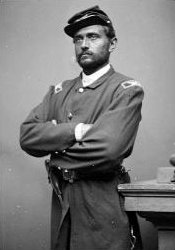
Augustus van Horne Ellis was an American lawyer, sea captain, and soldier. He was a brevet brigadier general in the Union Army during the Civil War, and was killed in action at the Battle of Gettysburg.
The 74th Pennsylvania Volunteer Infantry was an infantry regiment which served in the Union Army during the American Civil War. It was one of many all-German regiments in the army, most notably in the XI Corps of the Army of the Potomac. Its combat record was marred by the perceived poor performance of the entire corps at Chancellorsville and Gettysburg, when parts of the corps routed during Confederate attacks.

The 20th Indiana Volunteer Infantry Regiment was an infantry regiment that served in the Union Army during the American Civil War. The Regiment was officially raised on July 22, 1861, by William L. Brown, the first Colonel of the Regiment, in response to President Lincoln's call for volunteers. At the time of muster, the regiment had 9 fighting companies lettered A-K along with a staff company for a total of 10 companies, roughly 1000 men. The 20th Indiana saw engagements in most of the major battles of the American Civil War, including the action between the first ironclads at Hampton Roads, the Battle of Fredericksburg, the Battle of Gettysburg, and the Siege of Petersburg. The Regiment was part of the 1st Brigade, 3rd Division, III Corps for the duration of the war.

The 18th Georgia Infantry Regiment was an infantry regiment in the Confederate Army during the American Civil War. Originally brigaded with the three Texas regiments of John Bell Hood's Texas Brigade, it was transferred to Thomas R.R. Cobb's Georgia Brigade after the Battle of Antietam in late 1862. After General Cobb was mortally wounded at the Battle of Fredericksburg, the original colonel of the 18th Georgia, William T. Wofford, became Brigadier General of the Georgia Brigade.
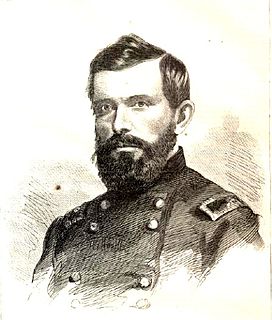
James Clay Rice was a lawyer from Massachusetts, who became a brigadier general of volunteers in the Union Army during the American Civil War.
The Thirteenth Pennsylvania Reserve Regiment, also known as the 42nd Pennsylvania Volunteer Infantry, the 1st Pennsylvania Rifles, Kane's Rifles, or simply the "Bucktails," was a volunteer infantry regiment that served in the Union Army during the American Civil War. It was a part of the famed Pennsylvania Reserve division in the Army of the Potomac for much of the early and middle parts of the war, and served in the Eastern Theater in a number of important battles, including Antietam, Fredericksburg, and Gettysburg.
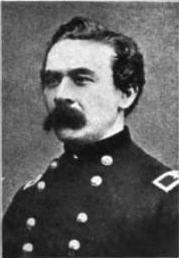
Thomas Wilberforce Egan was a Union Army officer who led the Mozart Regiment during most of the American Civil War, later becoming a general.
The 99th Regiment Pennsylvania Volunteer Infantry was an infantry regiment that served in the Union Army during the American Civil War.
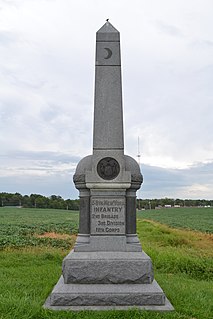
The 58th New York Infantry Regiment, also called the Polish Legion, was an infantry regiment of United States Volunteers in Union Army service during the American Civil War. The regiment was composed almost entirely of immigrant volunteers: Poles, Germans, Danes, Italians, Russians, and Frenchmen, most of whom were recruited at New York City in 1861.













